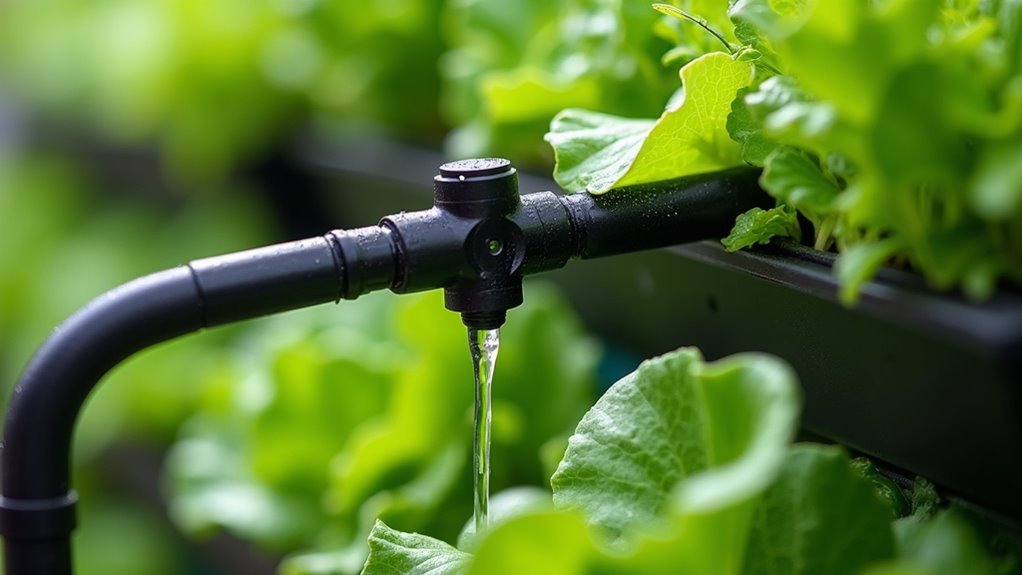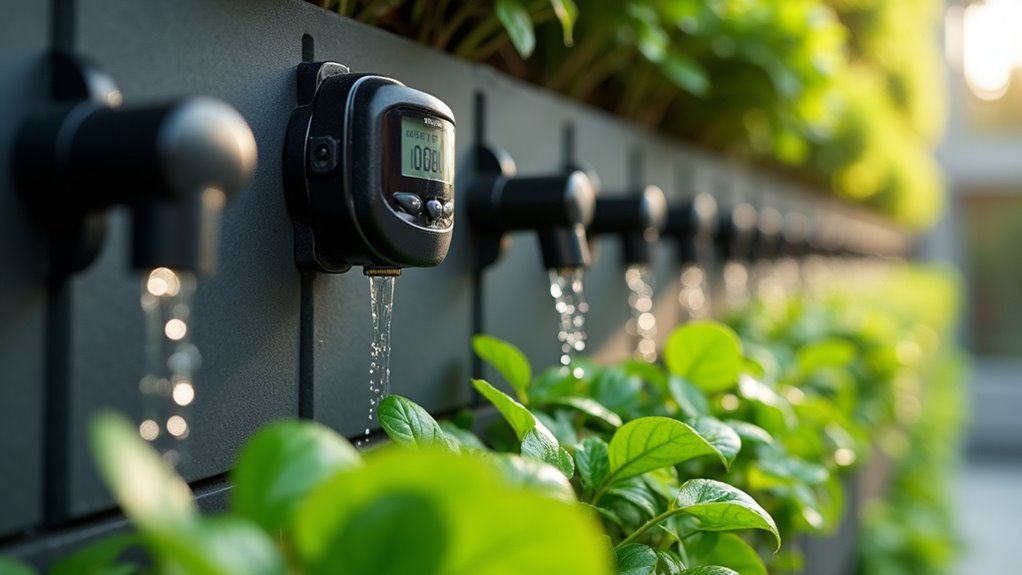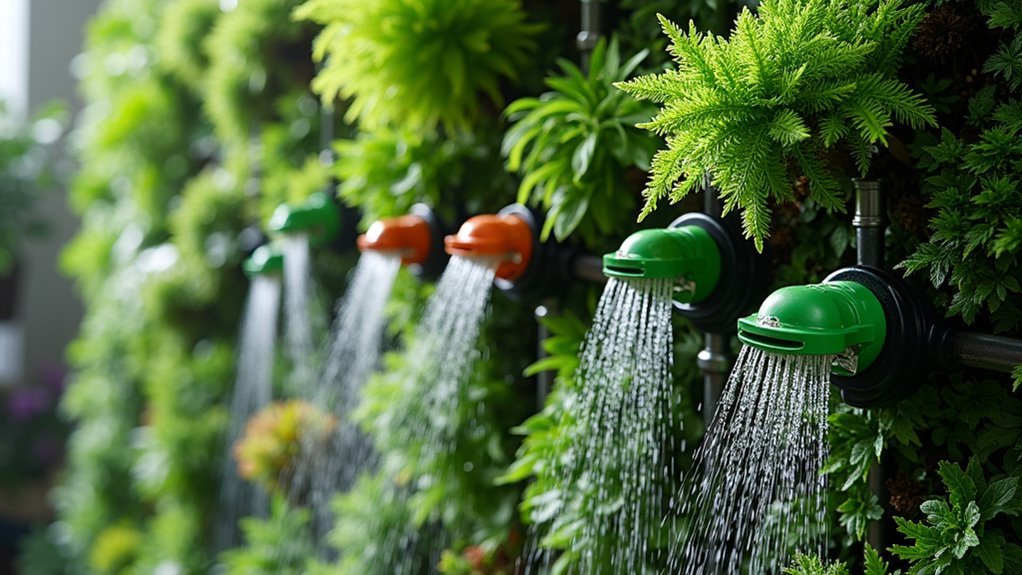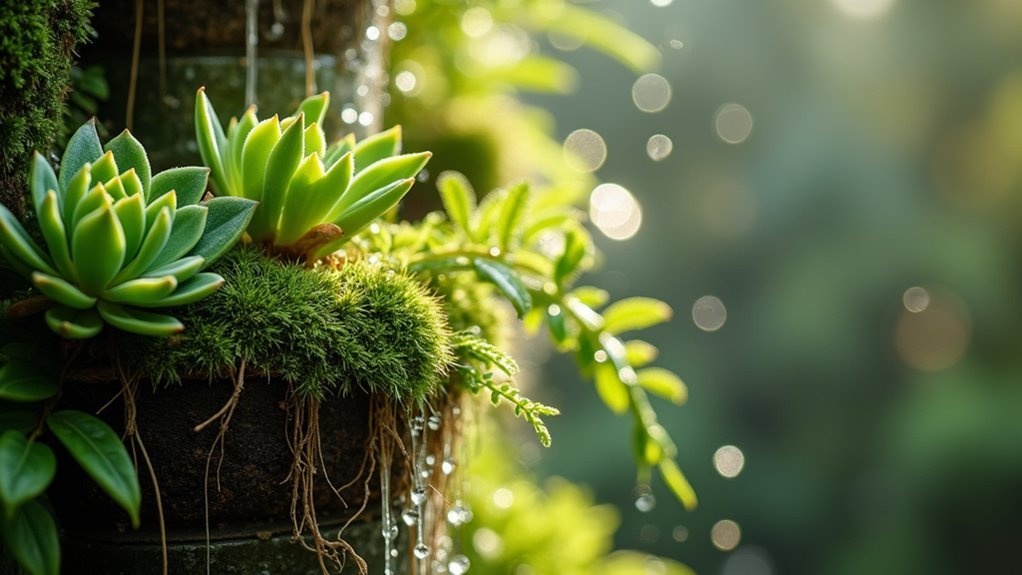You’ve invested in a stunning vertical garden, but you’re watching your water bills climb while your plants struggle with inconsistent moisture levels. Traditional watering methods simply don’t work for vertical setups—gravity, drainage, and plant positioning create unique challenges that require smart solutions. The difference between a thriving vertical garden and a costly mistake often comes down to implementing the right irrigation strategy that addresses these specific vertical growing constraints.
Choose the Right Watering System for Your Vertical Garden Setup

How can you guarantee your vertical garden thrives without wasting precious water or overwhelming your plants? Start by selecting a smart drip irrigation system that delivers water directly to plant roots, cutting water waste by up to 70% compared to traditional methods.
For vertical setups, gravity-fed systems work exceptionally well, utilizing natural water flow with minimal maintenance while requiring reservoir refills just once or twice weekly.
Enhance your system’s efficiency by incorporating moisture sensors that automatically adjust watering schedules based on real-time soil conditions. This smart home integration guarantees peak plant health while preventing overwatering.
Consider app-controlled systems for remote management, allowing precise irrigation adjustments that adapt to changing weather patterns and urban microclimates, maximizing both convenience and water conservation.
Install Smart Moisture Sensors to Monitor Plant Hydration Levels
Why settle for guesswork when smart moisture sensors can revolutionize your vertical garden’s watering precision?
These advanced devices measure soil moisture at multiple depths, delivering real-time data that eliminates overwatering and underwatering. You’ll achieve up to 50% reduction in water usage while promoting ideal plant health through targeted irrigation.
Smart moisture sensors deliver precise real-time data, reducing water usage by up to 50% while optimizing plant health through targeted irrigation.
Install sensors throughout your vertical garden’s different zones, connecting them to your irrigation system for automatic adjustments.
Many models offer mobile app integration, sending notifications when specific plants need water and allowing remote monitoring of hydration levels.
This technology transforms water conservation from reactive to proactive gardening.
You’ll prevent root rot, nutrient loss, and plant stress while supporting sustainable practices.
Smart moisture sensors guarantee each plant receives precisely what it needs, when it needs it.
Set up Automated Drip Irrigation With Programmable Timers

Three key components transform your vertical garden into a water-efficient powerhouse: automated drip irrigation, programmable timers, and strategic placement.
You’ll reduce water usage by up to 70% compared to traditional sprinklers while delivering moisture directly to plant roots.
Programmable timers guarantee consistent watering schedules, preventing over-watering and under-watering. You can customize watering durations for different plant species throughout your vertical setup.
When you integrate soil moisture sensors with your automated drip irrigation system, you’ll achieve real-time adjustments based on actual hydration needs.
Key setup benefits:
- Delivers water directly to root zones
- Reduces water waste by 70%
- Customizable schedules for different plants
- Smartphone app compatibility for remote control
- Real-time soil moisture monitoring
This combination promotes healthier plant growth while conserving precious water resources.
Create a Gravity-Fed Reservoir System for Consistent Water Flow
While automated systems offer convenience, a gravity-fed reservoir system provides the most reliable water flow for your vertical garden without electricity or complex components. Position your water reservoir above your garden’s highest point to guarantee consistent water distribution through natural gravitational force.
| Component | Function | Maintenance |
|---|---|---|
| Elevated Reservoir | Stores water supply | Refill 1-2x weekly |
| Gravity Flow Tubing | Delivers water downward | Check for clogs monthly |
| Drip Emitters | Controls water release | Clean quarterly |
| Flow Regulators | Maintains steady pressure | Inspect seasonally |
| Collection Tray | Catches excess water | Empty as needed |
This efficient design minimizes pressure fluctuations while integrating seamlessly with drip irrigation techniques. You’ll reduce water waste through targeted watering, and the system requires fewer components than pump-based alternatives, making it both cost-effective and environmentally sustainable.
Implement Zone-Based Watering for Different Plant Requirements

You’ll maximize your vertical garden’s efficiency by grouping plants with similar water requirements into distinct zones.
Configure separate irrigation lines for each zone so you can deliver precise amounts of water based on whether you’re growing succulents, herbs, or leafy greens.
Adjust your delivery systems with timers, drip emitters, or spray nozzles that match each zone’s specific moisture needs.
Group Plants by Needs
Although vertical gardens maximize growing space, they create unique watering challenges that demand strategic plant placement. When you group plants by needs, you’ll create an efficient watering system that prevents water waste and guarantees ideal plant health. Different species have vastly different moisture requirements that must be respected.
Consider these essential grouping strategies:
- Succulents and cacti – Low water requirements, drought-tolerant
- Leafy greens and herbs – Moderate, consistent moisture needs
- Flowering plants – Variable watering based on bloom cycles
- Root vegetables – Deep, infrequent watering patterns
- Tropical plants – High humidity and frequent watering
This strategic arrangement allows you to implement zone-based irrigation systems like drip lines or micro-sprinklers. You’ll conserve up to 70% more water while preventing overwatering damage to drought-tolerant plants.
Configure Multiple Irrigation Zones
Since different plant groups require distinct watering schedules, you’ll need to establish separate irrigation zones throughout your vertical garden structure.
Smart irrigation controllers enable independent operation for each zone, optimizing water delivery based on varying sun exposure and plant needs. You can reduce water consumption by 30-50% while delivering water directly where it’s needed most.
Install moisture sensors in each zone to provide real-time soil data, allowing automatic schedule adjustments. This technology prevents both overwatering and underwatering while reducing waste by up to 70% compared to traditional methods.
Remember to monitor and adjust your zones seasonally as plants grow and their requirements change. This zone-based approach guarantees each plant receives appropriate moisture while supporting sustainable gardening practices throughout your vertical space.
Adjust Water Delivery Systems
When you implement zone-based watering systems, you’re creating customized delivery networks that address each plant group’s distinct moisture requirements.
Your irrigation setup becomes more efficient when you group plants with similar water needs together, potentially reducing water usage by up to 70%.
Smart controllers can automatically adjust watering schedules based on weather data and real-time soil conditions.
You’ll achieve precise water application through micro-sprinkler kits or drip irrigation systems, eliminating overspray while ensuring ideal moisture levels.
- Group herbs and leafy greens together for streamlined scheduling
- Install soil moisture sensors for real-time data monitoring
- Use micro-sprinkler or drip systems for targeted water delivery
- Set up smart controllers that respond to weather changes
- Create separate zones based on plants’ specific moisture needs
Integrate Weather Monitoring to Adjust Irrigation Schedules
You’ll maximize your vertical garden’s water efficiency by connecting your irrigation system to real-time weather data that automatically adjusts watering schedules based on current conditions.
Your smart controller can modify timing and duration to prevent unnecessary watering during rain events, potentially reducing water consumption by up to 50%.
Rain sensors will halt your system when precipitation’s detected, while temperature monitoring guarantees your plants stay hydrated during heatwaves.
Real-Time Weather Data
While traditional irrigation relies on fixed schedules that can’t adapt to changing conditions, integrating real-time weather data transforms your vertical garden into a responsive ecosystem that automatically adjusts watering based on current environmental factors.
You’ll enhance water usage by connecting your system to live rainfall, temperature, and humidity readings, ensuring your plants receive precisely what they need when they need it. Smart controllers make real-time adjustments using local forecasts, preventing overwatering during rainy periods while maintaining ideal moisture levels for nutrient-rich water absorption.
- Rain sensors automatically halt irrigation when precipitation is detected
- Temperature monitoring adjusts watering frequency based on heat stress
- Humidity sensors prevent overwatering in moisture-rich conditions
- Wind speed data helps determine evaporation rates
- Microclimate tracking provides location-specific irrigation enhancement
Automated Schedule Adjustments
Building on this weather-responsive foundation, automated schedule adjustments take your irrigation system’s intelligence to the next level by dynamically modifying watering times, frequencies, and durations without any manual intervention. These automated systems integrate multiple data sources to create responsive watering schedules that adapt in real-time.
| Feature | Benefit |
|---|---|
| Rain sensors | Skip watering cycles, reducing waste up to 50% |
| WiFi weather forecasts | Adjust schedules based on temperature/humidity changes |
| Moisture sensors | Deliver precise water amounts based on actual soil conditions |
Your app-controlled system can customize schedules for different plant types while automatically responding to forecasted weather events. This intelligent approach guarantees your vertical garden receives ideal hydration while maximizing water conservation and plant health.
Rain Sensor Integration
Rain sensors serve as the cornerstone of intelligent weather monitoring, automatically detecting precipitation and instantly suspending your irrigation cycles to prevent unnecessary watering.
These devices can reduce water waste by up to 50% during rainy periods while ensuring your plants receive ideal moisture levels without overwatering risks.
In urban environments where every drop counts, rain sensors become essential for maximizing efficiency in limited space vertical gardens.
Modern smart irrigation systems seamlessly integrate with these sensors, providing real-time weather adjustments that promote healthier plant growth.
- Automatically suspend irrigation during rainfall to prevent overwatering
- Reduce water bills through efficient resource management
- Integrate seamlessly with existing smart irrigation systems
- Pair with additional weather monitoring tools for thorough data
- Support sustainable gardening practices in urban settings
Maintain Proper Drainage and Water Recirculation Systems
Because water management forms the backbone of any successful vertical garden, you’ll need to establish robust drainage and recirculation systems from the start.
Proper water management with effective drainage and recirculation systems is absolutely essential for vertical garden success.
Choose substrates that allow excess water to flow away from roots, preventing rot and waterlogging. Install drainage holes or channels throughout your design to facilitate water movement and prevent stagnation that causes fungal growth.
Set up recirculation systems that collect and redistribute excess water back to your garden’s top, minimizing waste while ensuring efficient water delivery.
Clean your drainage components regularly to prevent blockages that compromise plant health. Consider installing a smart irrigation controller that monitors moisture levels and automates recirculation, optimizing water delivery based on your plants’ real-time needs for maximum efficiency.
Frequently Asked Questions
How to Make a Smart Irrigation System?
You’ll install soil moisture sensors and smart relays like Shelly Pro 1 for smartphone control. Connect drip irrigation lines, integrate weather monitoring, and add rainwater harvesting systems to create an automated, water-efficient setup.
How Often Should I Water My Vertical Garden?
You should water your vertical garden every 2-3 days, but it depends on your plant types and environmental conditions. Use moisture sensors to check soil levels and avoid overwatering or underwatering stress.
Are There Any Drawbacks to Using Vertical Gardens?
You’ll face higher maintenance costs, complex irrigation needs, and increased vulnerability to water issues. Power outages can disrupt automated systems, and you’ll need constant monitoring to prevent plant death in your vertical setup.
What Is the Best Way to Automate Garden Watering?
You’ll get the best results by installing drip irrigation with moisture sensors and app-controlled timers. This combination delivers water directly to roots, monitors soil conditions automatically, and adjusts schedules based on weather data.





Leave a Reply